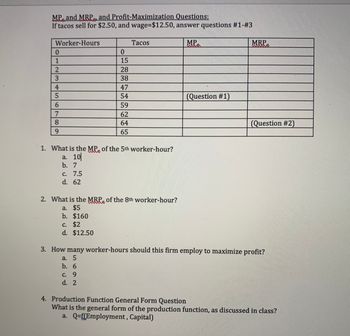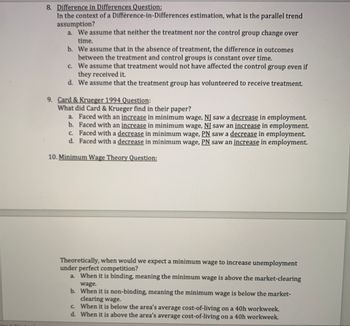
ENGR.ECONOMIC ANALYSIS
14th Edition
ISBN: 9780190931919
Author: NEWNAN
Publisher: Oxford University Press
expand_more
expand_more
format_list_bulleted
Question
Please help with questions 8-10
thank you

Transcribed Image Text:MP and MRP, and Profit-Maximization Questions:
If tacos sell for $2.50, and wage=$12.50, answer questions #1-#3
Worker-Hours
0
1
23456789
c. 7.5
d. 62
0
15
28
38
47
54
59
62
64
65
1. What is the MP of the 5th worker-hour?
a. 10
b. 7
c. $2
d. $12.50
Tacos
2. What is the MRP of the 8th worker-hour?
a. $5
b. $160
MP
(Question #1)
MRP
(Question #2)
3. How many worker-hours should this firm employ to maximize profit?
a. 5
b. 6
c. 9
d. 2
4. Production Function General Form Question
What is the general form of the production function, as discussed in class?
a. Q=f(Employment, Capital)

Transcribed Image Text:8. Difference in Differences Question:
In the context of a Difference-in-Differences estimation, what is the parallel trend
assumption?
a. We assume that neither the treatment nor the control group change over
time.
b. We assume that in the absence of treatment, the difference in outcomes
between the treatment and control groups is constant over time.
c. We assume that treatment would not have affected the control group even if
they received it.
d.
We assume that the treatment group has volunteered to receive treatment.
9. Card & Krueger 1994 Question:
What did Card & Krueger find in their paper?
b.
a. Faced with an increase in minimum wage, NI saw a decrease in employment.
Faced with an increase in minimum wage, NI saw an increase in employment.
c. Faced with a decrease in minimum wage, PN saw a decrease in employment.
d. Faced with a decrease in minimum wage, PN saw an increase in employment.
10. Minimum Wage Theory Question:
Theoretically, when would we expect a minimum wage to increase unemployment
under perfect competition?
a. When it is binding, meaning the minimum wage is above the market-clearing
wage.
b. When it is non-binding, meaning the minimum wage is below the market-
clearing wage.
c.
When it is below the area's average cost-of-living on a 40h workweek.
d. When it is above the area's average cost-of-living on a 40h workweek.
Expert Solution
This question has been solved!
Explore an expertly crafted, step-by-step solution for a thorough understanding of key concepts.
Step by stepSolved in 3 steps

Knowledge Booster
Learn more about
Need a deep-dive on the concept behind this application? Look no further. Learn more about this topic, economics and related others by exploring similar questions and additional content below.Similar questions
- Define the term Expenses?arrow_forwardFill in the table below, giving a numerical value for letters A, B, C, and D. TC AFC AVC 50 1 90 A B D 30 2.arrow_forwardIf a consumer's Engle curve for a certain product is downward sloping then (a) the product must be a normal good. (b) the product must be an inferior good. (c) the product must be a bad. (d) the product must be a neuter. +arrow_forward
- Question 32 Which points represent a production level that could lead to unemployment? 12 10 Thousands of sedans 8 9 4 A 2 D B C 0- 0 2 4 6 8 10 12 Thousands of convertibles Full text description Selected answer will be automatically saved. For keyboard navigation, press up/down arrow keys to select an answer. Q Searcharrow_forwardWhat is the AVC and MC?arrow_forwardWhats a problem customers face with LCD Panels Battery issues?arrow_forward
- What are the ethical issues that could be encountered when running an e-commerce platform?arrow_forwardAutoSave File Document! Word Chris Navo Home Insert Draw Design Layout References Mailings Review View MathType Help Acrobat Graphs Format Cobb and Douglas used economic data published by the government to obtain Table 2. Year P Year 1899 100 100 DOL 1911 148 216 1900 101 105 107 1912 155 1901 112 110 114 1912 1902 122 117 122 1014 169 152 244 1903 124 122 131 1915 109 156 266 1904 122 121 138 1916 225 183 1905 143 125 149 1917 227 1905 152 124 163 1915 223 201 1907 151 140 170 1919 218 19.08 126 123 485 1920 231 104 407 19.09 155 143 198 1921 179 146 417 1910 159 208 1922 240 161 431 Table 2 Swords et Predictions. The Cobb Douglass formula is P(L, K) = bLa K¹-a Determine monetary value of all the goods produced in 1 year or simply the production level in 1920 for a=.20 and b=1.01. Round to one decimal place.arrow_forwardWhat is the 4p ( Product, price, place, promotion) of caribou coffee ?arrow_forward
arrow_back_ios
SEE MORE QUESTIONS
arrow_forward_ios
Recommended textbooks for you

 Principles of Economics (12th Edition)EconomicsISBN:9780134078779Author:Karl E. Case, Ray C. Fair, Sharon E. OsterPublisher:PEARSON
Principles of Economics (12th Edition)EconomicsISBN:9780134078779Author:Karl E. Case, Ray C. Fair, Sharon E. OsterPublisher:PEARSON Engineering Economy (17th Edition)EconomicsISBN:9780134870069Author:William G. Sullivan, Elin M. Wicks, C. Patrick KoellingPublisher:PEARSON
Engineering Economy (17th Edition)EconomicsISBN:9780134870069Author:William G. Sullivan, Elin M. Wicks, C. Patrick KoellingPublisher:PEARSON Principles of Economics (MindTap Course List)EconomicsISBN:9781305585126Author:N. Gregory MankiwPublisher:Cengage Learning
Principles of Economics (MindTap Course List)EconomicsISBN:9781305585126Author:N. Gregory MankiwPublisher:Cengage Learning Managerial Economics: A Problem Solving ApproachEconomicsISBN:9781337106665Author:Luke M. Froeb, Brian T. McCann, Michael R. Ward, Mike ShorPublisher:Cengage Learning
Managerial Economics: A Problem Solving ApproachEconomicsISBN:9781337106665Author:Luke M. Froeb, Brian T. McCann, Michael R. Ward, Mike ShorPublisher:Cengage Learning Managerial Economics & Business Strategy (Mcgraw-...EconomicsISBN:9781259290619Author:Michael Baye, Jeff PrincePublisher:McGraw-Hill Education
Managerial Economics & Business Strategy (Mcgraw-...EconomicsISBN:9781259290619Author:Michael Baye, Jeff PrincePublisher:McGraw-Hill Education


Principles of Economics (12th Edition)
Economics
ISBN:9780134078779
Author:Karl E. Case, Ray C. Fair, Sharon E. Oster
Publisher:PEARSON

Engineering Economy (17th Edition)
Economics
ISBN:9780134870069
Author:William G. Sullivan, Elin M. Wicks, C. Patrick Koelling
Publisher:PEARSON

Principles of Economics (MindTap Course List)
Economics
ISBN:9781305585126
Author:N. Gregory Mankiw
Publisher:Cengage Learning

Managerial Economics: A Problem Solving Approach
Economics
ISBN:9781337106665
Author:Luke M. Froeb, Brian T. McCann, Michael R. Ward, Mike Shor
Publisher:Cengage Learning

Managerial Economics & Business Strategy (Mcgraw-...
Economics
ISBN:9781259290619
Author:Michael Baye, Jeff Prince
Publisher:McGraw-Hill Education